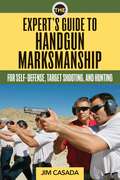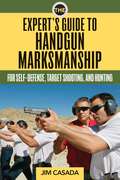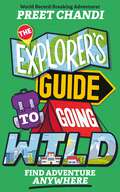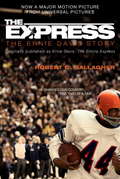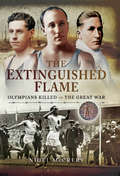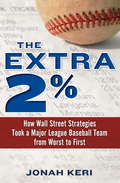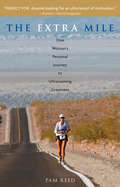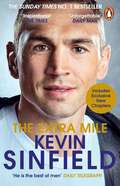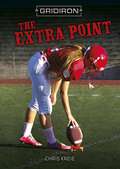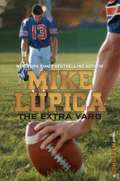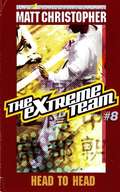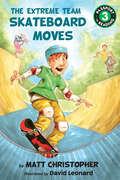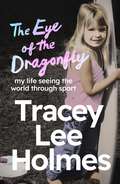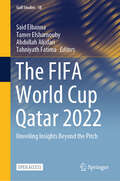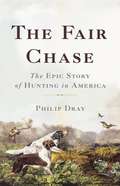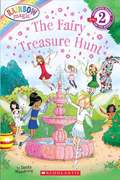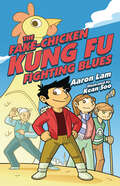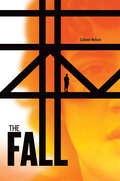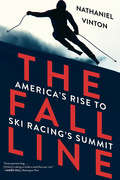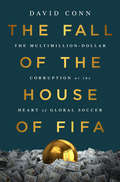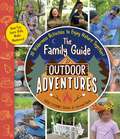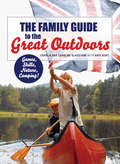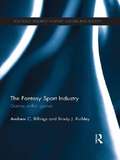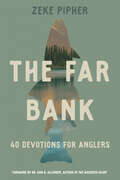- Table View
- List View
The Expert's Guide to Handgun Marksmanship
by Jim CasadaFor self-defense with a handgun, target shooting, or hunting, this new book is a must read! The expertise of the world's leading handgun experts-Charles Askins, Jr., Jeff Cooper, Julian S. Hatcher, Jack O'Connor, William Reichenbach, plus excerpts from US Army Field Manuals-is brought together for the first time in this convenient pocket-sized edition-everything you need to know to improve upon your handgun marksmanship skills.This informative, 160-page, fact-filled book is guaranteed to improve your handgun accuracy.
The Expert's Guide to Handgun Marksmanship: For Self-Defense, Target Shooting, and Hunting
by Jim CasadaFor self-defense with a handgun, target shooting, or hunting, this new book is a must read! The expertise of the world’s leading handgun experts-Charles Askins, Jr., Jeff Cooper, Julian S. Hatcher, Jack O’Connor, William Reichenbach, plus excerpts from US Army Field Manuals-is brought together for the first time in this convenient pocket-sized edition-everything you need to know to improve upon your handgun marksmanship skills.This informative, 160-page, fact-filled book is guaranteed to improve your handgun accuracy.Skyhorse Publishing is proud to publish a broad range of books for hunters and firearms enthusiasts. We publish books about shotguns, rifles, handguns, target shooting, gun collecting, self-defense, archery, ammunition, knives, gunsmithing, gun repair, and wilderness survival. We publish books on deer hunting, big game hunting, small game hunting, wing shooting, turkey hunting, deer stands, duck blinds, bowhunting, wing shooting, hunting dogs, and more. While not every title we publish becomes a New York Times bestseller or a national bestseller, we are committed to publishing books on subjects that are sometimes overlooked by other publishers and to authors whose work might not otherwise find a home.
The Explorer's Guide to Going Wild: Find Adventure Anywhere
by Preet ChandiADVENTURE CAN BE FOUND JUST OUTSIDE THE DOOR A must-have book for kids who love to explore. Written by EXPLORER OF THE YEAR 2023, MBE Preet Chandi. Do you know a child who loves to explore but isn't sure how to plan their own adventures? Are they often preoccupied by an iPad when they could be outdoors? Then this is the perfect book for them! In this book, kids will learn how they can become a master explorer. Whether they want to learn how to camp in the wild, navigate their way through a new landscape, master bushcraft skills or plan a polar expedition, this book will show them how to do it.Each chapter has a mini challenge for young explorers to try at home, from learning how to read the stars to building a den. All these skills will help children to push their boundaries, build a resilient explorer mindset and get outdoors. And with fun black and white illustrations, having an adventure couldn't be easier! Written by world record-breaking adventurer 'Polar' Preet, who has been on adventures all around the world: from navigating 40 days on the Antarctic ice and a 700-mile journey to the South Pole to racing through the deserts of South Sudan. Preet shares tales of her own expeditions, big and small, as well as practical things kids can do, to inspire her readers to try new things and have their own adventures (even on their doorsteps!).Children will want to grab a copy, step outside and start creating their own adventure stories.
The Express
by Robert C. Gallagher"He could do it all, beat every opponent . . . except one."-plaque honoring Ernie Davis, in the lobby of Elmira Free AcademyErnie Davis was an All-American on the gridiron, and a man of integrity off the field. A multi-sport high school star in Elmira, New York, Davis went on to Syracuse University, where as a sophomore he led his team to an undefeated season and a national championship in 1959, and earned his nickname, the Elmira Express. Two seasons later, Davis had broken the legendary Jim Brown's rushing records, and became the first black athlete to be awarded the Heisman Trophy. The number one pick in the 1962 NFL draft, Davis signed a contract with the Cleveland Browns and appeared to be headed for professional stardom. But Davis never ended up playing in the NFL: He was diagnosed with leukemia during the summer before his rookie season and succumbed to the disease less than a year later. In battling his illness, Davis showed great dignity and courage, inspired the nation, and moved President John F. Kennedy to eulogize him as " an outstanding man of great character."An enduring story of a true scholar-athlete, The Express is a touching, impeccably researched, deeply personal portrait of Ernie Davis, and a vivid look at sport in America at the dawn of the Civil Rights era.From the Trade Paperback edition.
The Extinguished Flame: Olympians Killed in The Great War
by Nigel McCreryIn August 2016 the world will be spellbound by the Olympic Games in Rio de Janeiro as 10,500 athletes from 206 countries compete in 306 events. Tracing their origins back to the Greeks in 776 BC, the history of the Olympics is a glorious one but it has had its darker moments.During the First World War no fewer than 135 Olympians perished. Many had won Gold, Silver and Bronze medals. They came not just from the UK, Germany, France, USA but from all over the globe.Wyndham Halswelle, killed in action on 31 March 1915, won a Gold, Silver and Bronze medals in both field and track events. The Frenchman Leon Flameng, the fastest cyclist ever, died on 2 January 1917, having won Gold, Silver and Bronze medals in the 1896 Olympics. The German Fritz Bartholomae, killed in action 12 September 1915, won a Bronze in the rowing eights during the 1912 Olympics. The list of these heroes goes on and on. Each Olympian, who made the supreme sacrifice, is honoured in this magnificent book by a summary of their life, sporting achievement and manner of their death.
The Extra 2%: How Wall Street Strategies Took a Major League Baseball Team from Worst to First First
by Jonah KeriWhat happens when three financial industry whiz kids and certified baseball nuts take over an ailing major league franchise and implement the same strategies that fueled their success on Wall Street? In the case of the 2008 Tampa Bay Rays, an American League championship happens--the culmination of one of the greatest turnarounds in baseball history. In The Extra 2%, financial journalist and sportswriter Jonah Keri chronicles the remarkable story of one team's Cinderella journey from divisional doormat to World Series contender. When former Goldman Sachs colleagues Stuart Sternberg and Matthew Silverman assumed control of the Tampa Bay Devil Rays in 2005, it looked as if they were buying the baseball equivalent of a penny stock. But the incoming regime came armed with a master plan: to leverage their skill at trading, valuation, and management to build a model twenty-first-century franchise that could compete with their bigger, stronger, richer rivals--and prevail. Together with "boy genius" general manager Andrew Friedman, the new Rays owners jettisoned the old ways of doing things, substituting their own innovative ideas about employee development, marketing and public relations, and personnel management. They exorcized the "devil" from the team's nickname, developed metrics that let them take advantage of undervalued aspects of the game, like defense, and hired a forward-thinking field manager as dedicated to unconventional strategy as they were. By quantifying the game's intangibles--that extra 2% that separates a winning organization from a losing one--they were able to deliver to Tampa Bay something that Billy Beane's "Moneyball" had never brought to Oakland: an American League pennant. A book about what happens when you apply your business skills to your life's passion, The Extra 2% is an informative and entertaining case study for any organization that wants to go from worst to first.From the Hardcover edition.
The Extra Mile: One Woman's Personal Journey to Ultrarunning Greatness
by Pam ReedOne year after her astonishing victory at the Badwater Ultramarathon, Pam Reed again made distance running history when she braved the hottest weather in years—135 degrees—to successfully defend her title. How does this 100-pound mother and stepmother of five muster the endurance and courage for the 28-hour climb from the hottest desert floor on Earth to the shadow of the continental United States' tallest point? In The Extra Mile we watch this ultramarathon champion seek balance in her life as a wife, mother, athlete, and entrepreneur. With astonishing candor she tells of her 15-year-long battle with anorexia. And she helps us to understand her passion for ultrarunning—to discover how far the human body can be pushed.
The Extra Mile: The Inspirational Number One Bestseller
by Kevin SinfieldTHE INSTANT, NUMBER ONE BESTSELLERThe extraordinary memoir of the sporting icon, devoted friend and fundraising hero who has inspired the nation in his fight against MND'An inspirational and life-affirming read. What Kevin Sinfield has achieved on and off the field is truly remarkable. His inspiring leadership and relentless focus on fundraising for MND shows how we should all strive to care more for each other' Gareth Southgate'If you want inspiring, uplifting and empowering... give this amazing man some of your time' Jake Humphrey'Kevin Sinfield is adored and respected . . . he is the best of men' Brian Moore, Daily Telegraph'I've always thought Kevin Sinfield was a hero. His quiet, calm, committed leadership makes people want to support him and we are all doing that as he supports Rob Burrow and everyone living with MND' Clare Balding'The friendship between Kevin Sinfield and Rob Burrow gives you faith in humankind' Sir Chris HoyThe Extra Mile is no ordinary sports memoir. But Kevin Sinfield is no ordinary sportsman. A one-club legend of Leeds Rhinos, who has now crossed codes as a defence coach for the England national rugby union team, Kevin Sinfield is a rugby icon. But in recent years has shown heroism of a very different kind through his selfless and extraordinary fundraising for motor neurone disease (MND), the terminal illness that has affected his best mate and former teammate Rob Burrow.Sinfield's epic challenges have included running 7 ultra marathons in 7 days, and running over 101 miles in 24 hours. In the process, Sinfield has captured the hearts of the nation and over £7 million for MND. He was awarded an OBE in the Queen's Birthday honours for his efforts, along with the Freedom of Leeds and a special BBC Award for his fundraising.Told with Sinfield's characteristic warmth, dry wit and inspirational leadership, The Extra Mile is the story of an astonishing life, of an enduring friendship, of perseverance against the most difficult of challenges, and of a remarkable, humble human being who has defied the odds. The book equips readers with the tools and the mindset to embrace togetherness and to overcome their own challenges. It leaves the reader with the urgent question: Who would you go the extra mile for to help in life?PRAISE FOR KEVIN SINFIELD'Inspirational does not do him justice, he's that and much, much more' Matt Dickinson'Kevin Sinfield is an incredible human being' Gabby Logan'A total hero' Yvette Cooper'Britain's greatest sportsman (off the pitch) ... Kevin Sinfield's fundraising is a poignant story of friendship and human endeavour' The Times
The Extra Point (Gridiron)
by Chris KreieAfter she gets cut from the soccer team her senior year, Riley doesn't know what to do. She had the best kick on the team but wasn't fast enough. When the high school football team is in desperate need of a new kicker, Riley decides to go for it. But swapping a soccer ball for a football isn't so easy. Riley has to learn how to kick a football and deal with a teammate who isn't happy about her being on the team. When it comes down to the wire, will her natural talent be enough? Or will Riley crack under the pressure?
The Extra Yard
by Mike LupicaTeddy, a young football player, learns that sometimes bridging the distance in your family can be harder than stretching for an extra yard on the field in the second book of the Home Team series from New York Times bestselling author and sportswriting legend Mike Lupica.Last spring Teddy's life changed for the better. He started working out, shaping up, and even earned a spot on the Walton baseball team, and with the team he went all the way to the Little League World Series. But the best things to come out of that season were his friendships with Jack, Cassie, and Gus, and the confidence to finally try out for the sport he really loves--football. So when eighth grade begins, Teddy couldn't be more psyched. Until his mom drops a bomb: his father--who left them a long time ago--is back in Walton and back in their lives. And Teddy isn't happy about it. As a former star football player at the school, Teddy's dad is thrilled to find out his son is going out for the team, but Teddy begins to wonder if his father only cares about him now because he's putting on the helmet. Can Teddy find a way to go the extra yard for the team and for himself, or is the distance between him and his father too much to overcome?
The Extreme Team #8: Head to Head (The Extreme Team #8)
by Matthew F ChristopherMark finds that he is jealous when his friend Jonas seems to learn kung fu much more quickly than he did.
The Extreme Team: Skateboard Moves
by Matt Christopher David LeonardCharlie Abbott is the new kid in town--again. He hates everything about moving, especially trying to make new friends. Then he meets a kid called X who shares his love of skateboarding. Together, they rip some moves at the town skatepark. But then Charlie's skateboard vanishes from his garage, and he sees X riding around on a skateboard that looks just like his! Is Charlie's new life about to become a disaster?Passport to Reading Level 3
The Eye of the Dragonfly: My Life Seeing the World Through Sport
by Tracey Lee HolmesFor celebrated journalist Tracey Lee Holmes, sport has been both a way of life and a lens through which to look at life itself. In this completely candid, wide-ranging and passionate book – part memoir, part manifesto – she shares both her stories and her views on sport&’s most dramatic issues. The dragonfly sees in 360 degree perspective, and that&’s what Tracey Lee Holmes has always done in her sports journalism. Over four decades, she has taken us beyond the scores and stats to the real stories of sport – the stories of human beings in exultation and defeat, and the bigger stories of money, power, and all too often, discrimination. In both her life and work, Holmes has consistently broken barriers. The first female presenter of the ABC&’s flagship sports programme, Grandstand, she has pioneered coverage of and by women in sport. Her longform style of interviewing and her reporting on world events like the Olympics and FIFA World Cups have introduced us to athletes from all backgrounds and nations, from our own Cathy Freeman and James Hird to Ayrton Senna and Pele. Anchor, reporter, podcaster and – for a rocky spell over the 2000 Sydney Olympics – media manager, Holmes has never sought to divorce sport and the politics of the world it&’s played in. As well as recounting highlights (and a couple of lowlights) from her career, in this book she shares her views on drugs in sport, Sam Kerr, and what challenges face the Olympics before the 2032 Brisbane Games. Holmes has also had a rich personal story. The child of itinerant surfers, she has lived in many different countries with her own children and husband, Stan Grant, seeing the world from many different perspectives. And her life has been full of surprises: only after numerous years living in China did she learn that she has Chinese heritage herself. Bracing, intimate and characteristically unconventional, The Eye of the Dragonfly gives us the full picture of a remarkable life in sport.
The FIFA World Cup Qatar 2022: Unveiling Insights Beyond the Pitch (Gulf Studies #18)
by Said Elbanna Tamer Elsharnouby Abdullah Aljafari Tahniyath FatimaThis open access book presents a collection of case studies to analyse the FIFA World Cup 2022 held in Qatar, which revealed several complex aspects related to global football – its organization, its community, its related power dynamics, and its socio-economic implications. Behind this mega event lay unspoken narratives about the difficulties of hosting this global tournament in Qatar. This book takes the reader on a journey along the numerous strands connected to this multifaceted event. The case studies excavate both the best practices and the challenges that public policymakers and institutions in Qatar encountered in organizing the FIFA World Cup, including the pressures from various stakeholders involved, including FIFA, the sponsors, the football fans, and the local residents of Qatar. One such case sheds light on the debate surrounding the linkage between government-spending and the subsequent economic impact of hosting such a mega sporting event. The collection also delves into nuanced discussions about volunteering behaviour. Several case studies approach the central questions of sustainability and related implications following the Qatar event. As the first football World Cup to take place in a Middle Eastern country, the case studies also spotlight the role of cultural differences and associated implications, such as nation branding. Relevant to sociologists, economists, business and marketing researchers, and sports studies researchers, this book is a unique compilation bringing together multiple interdisciplinary, critical perspectives on Qatar's FIFA experience – from within the region, and beyond.
The Fair Chase: The Epic Story of Hunting in America
by Philip DrayAn award-winning historian tells the story of hunting in America, showing how this sport has shaped our national identity.From Daniel Boone to Teddy Roosevelt, hunting is one of America's most sacred-but also most fraught-traditions. It was promoted in the 19th century as a way to reconnect "soft" urban Americans with nature and to the legacy of the country's pathfinding heroes. Fair chase, a hunting code of ethics emphasizing fairness, rugged independence, and restraint towards wildlife, emerged as a worldview and gave birth to the conservation movement. But the sport's popularity also caused class, ethnic, and racial divisions, and stirred debate about the treatment of Native Americans and the role of hunting in preparing young men for war. This sweeping and balanced book offers a definitive account of hunting in America. It is essential reading for anyone interested in the evolution of our nation's foundational myths.
The Fairy Treasure Hunt
by Daisy MeadowsThe Jewel Fairies are going on a treasure hunt! Time for a treasure hunt! The Jewel Fairies are searching Fairyland for the magical jewels that give all fairies their special powers. If they can find them all, they will be granted a very special gift-- beautiful jeweled pendants! After a very busy day, only one is left. The fairies must combine their magic to help Sophie the Sapphire earn her necklace.
The Fake-Chicken Kung Fu Fighting Blues (Lorimer Illustrated Humor)
by Aaron LamTwelve-year-old video buff Anthony is devastated when his family moves from Chinatown to a remote northern community. There are no other Asian families around and everyone loves hockey, which Anthony just doesn't get. The move is even harder on his grandmother, Po Po, who doesn't speak English and puts a fake chicken over the front door for luck. Desperate to fit in, Anthony takes to the ice for the first time — and is a total disaster! But he manages to make friends after standing up the school bully, who asks Anthony to teach him "kung fu"! Anthony starts putting together a documentary about his new town, which turns out to be full of interesting people. As he discovers the joys of small-town life, his new friends get an introduction to his Chinese culture, and even Po Po begins to feel at home. Distributed in the U.S by Lerner Publishing Group
The Fall
by Colleen NelsonWINNER, McNally Robinson Book for Young People Award, 2014FINALIST, Forest of Reading, White Pine Award 2013SELECTION, Best Books for Kids and Teens, Fall 2013When one teen dies in a tragic accident, the lives of three others are forever changed. One turns to alcohol to escape his guilt. Another looks to a gang to replace what he' s lost. Ben must find the strength to break through a growing web of lies and convince everyone at school that he was not to blame. But first he has to convince himself.
The Fall Line: America's Rise to Ski Racing's Summit
by Nathaniel VintonA journey into the world's original extreme sport: downhill ski racing. Harnessing nature's most powerful forces, elite downhillers descend icy, rugged slopes at speeds cresting 90 miles per hour. For decades, American skiers struggled to match their European counterparts, and until this century the US Ski Team could not claim a lasting foothold on the roof of the Alps, where the sport's legends are born. Then came a fledgling class of American racers that disrupted the Alpine racing world order. Led by Bode Miller and Lindsey Vonn, Julia Mancuso and Ted Ligety, this band of iconoclasts made a place for their country on some of the world's most prestigious race courses. Even as new technology amplified the sport's inherent danger, the US Ski Team learned how to win, and they changed downhill racing forever. The Fall Line is the story of how it all came together, a deeply reported reconstruction of ski racing's most dramatic season. Drawing on more than a decade of research and candid interviews with some of the sport's most elusive figures, award-winning journalist Nathaniel Vinton reveals the untold story of how skiers like Vonn and Miller, and their peers and rivals, fought for supremacy at the Olympic Winter Games. Here is an authoritative portrait of a group of men and women taking mortal risks in a bid for sporting glory. A white-knuckled tour through skiing's deep traditions and least-accessible locales, The Fall Line opens up the sexy, high-stakes world of downhill skiing--its career-ending crashes, million-dollar sponsorship deals, international intrigue, and showdowns with nature itself. With views from the starting gate, the finish line, and treacherous turns in between, The Fall Line delivers the adrenaline of one of the world's most beautiful and perilous sports alongside a panoramic view of skiing's past, present, and future.
The Fall of the House of FIFA: The Multimillion-Dollar Corruption at the Heart of Global Soccer
by David ConnIn 2015, FIFA-the multibillion dollar governing body of the world's most-loved sport-was brought down by allegations of industrial-scale bribes, kickbacks, money laundering, racketeering and tax evasion. <P><P>Beginning with early morning raids in Zurich and the indictment of twenty-seven executives by the US Department of Justice, the rottenness at the core of FIFA seemed to extend throughout all of soccer, from the decision to send the 2018 and 2022 World Cups to Russia and Qatar to lesser known cases of embezzlement from Trinidad to South Africa. <P><P>David Conn writes the definitive account of FIFA's rise and fall, covering in great detail the corruption allegations and the series of scandals that continued to shake the public's trust in the organization. <P><P>The Fall of the House of FIFA situates FIFA's unraveling amidst revealing human portraits of soccer legends such as Michel Platini and Franz Beckenbauer and features an exclusive interview with former president Sepp Blatter. Even as he chronicles the biggest sport scandal of all time, Conn infuses the book with a passionate love of the game, delivering an irresistible read.
The Family Guide to Outdoor Adventures: 30 Wilderness Activities to Enjoy Nature Together!
by Creek StewartExplore and experience nature with your kids with these 30 fun and educational family activities dedicated to spending more time outside.Less screen, more green! In the world of smartphones, tablets, and online learning, the need for children to engage with nature has never been more evident. Outdoor activities and projects inspire exploration, creativity, curiosity, learning, and a sense of wonder. Interacting with nature also fosters a healthy love and respect for the outdoors. The Family Guide to Outdoor Adventures features fun and engaging hands-on nature, camping, and bushcraft projects that get you and your children outside having more fun, strengthening your bond, and creating memories that will last a lifetime. Written by expert survival instructor Creek Stewart, each project is designed to get parents and their kids outside and teach them about nature and the great outdoors. From casting animal tracks and dyeing t-shirts with walnuts to building a debris hut and catching minnows with a spider web your family with get your hands dirty, learn some cool nature facts, and complete some awesome projects with your family. Explore, create, laugh, love, and experience the great outdoors together with The Family Guide to Outdoor Adventures.
The Family Guide to the Great Outdoors
by Charlie GladstoneGetting outdoors brings the whole family together. You’ll learn skills, have a run-around, share laughs, and make enduring memories.This book is the perfect companion to any outdoor family adventure. From countryside camping holidays to weekends roaming fields and parks, it will inspire you to enjoy the outdoors whatever the weather. It covers everything for kids (and big kids) to do outdoors, including:- Cloud identification- Great British walks- Building dams and dens- Campfires and woods- Camping recipes- Common British trees
The Family You Make: Fall in love with Sunrise Cove in this heart-warming story of love and belonging
by Jill ShalvisBeloved New York Times bestselling author Jill Shalvis begins a new series - Sunrise Cove - set near beautiful Lake Tahoe, with a heartwarming story of found family and love.'Perfect, feel-good fiction' Sarah Morgan'Fall in love with Jill Shalvis! She's my go-to read for humor and heart' Susan Mallery, New York Times bestselling authorReaders are already loving The Family You Make!'A strong 5 star read! . . . I absolutely adored this book''I couldn't put it down and didn't want it to end. I loved it''(A) beautiful and heartbreaking love story with a much deserved HEA'...............................................................................................Is this the life she was always meant to have? During the snowstorm of the century Levi Cutler is stranded on a ski lift with a beautiful stranger named Jane. When the gondola in front of them hurtles to the ground, Levi calls his parents, but can't bring himself to say goodbye. Instead, he impulsively reveals that he's happily settled and Jane is his girlfriend - right before his phone dies. But Levi and Jane do not. Now Levi's family is desperate to meet 'The One'. Jane agrees to be his pretend girlfriend for just one dinner, but a traumatic childhood has left her unsure how to act around a tight-knit family that cherishes one another. As Jane and Levi spend more time together, pretend feelings quickly turn into real ones. Now all Jane has to do is admit to herself she can't live without the man she's fallen in love with - and the family she has always dreamed of................................................................................................Raves for Jill Shalvis's life-affirming novels'Jill Shalvis's books are funny, warm, charming and unforgettable' RaeAnne Thayne, New York Times bestselling author'Sisterhood takes center stage in this utterly absorbing novel. Jill Shalvis balances her trademark sunny optimism and humor with unforgettable real-life drama. A book to savor - and share' Susan Wiggs, New York Times Bestselling Author'Readers will find it easy to root for Shalvis's stubborn, vulnerable heroines to recognize both the decency and compassion of the sexy men who love them and their own worthiness to be loved. This heartfelt tale is thoroughly satisfying' Publishers Weekly
The Fantasy Sport Industry: Games within Games (Routledge Research in Sport, Culture and Society)
by Andrew C. Billings Brody J. RuihleyFantasy sport has become big business. Recent estimates suggest that there as many as 33 million fantasy sport participants in the US alone, spending $3bn annually, with many millions more around the world. This is the first in-depth study of fantasy sport as a cultural and social phenomenon and a significant and growing component of the contemporary sports economy. This book presents an overview of the history of fantasy sport and its close connection to innovations in sports media. Drawing on extensive empirical research, it offers an analysis of the demographics of fantasy sport, the motivations of fantasy sport players and their significance as heavy consumers of sport media and as ultra-fans. It also draws cross-cultural comparisons between fantasy sport players in the US, UK, Europe and beyond. The Fantasy Sport Industry examines the key commercial and media stakeholders in the production and development of fantasy sport, and points to new directions for the fantasy sport industry within modern sport business. It is therefore, fascinating reading for any student, scholar or professional with an interest in sports media, sports business, fandom, the relationship between sport and society, or cultural studies.
The Far Bank: 40 Devotions for Anglers
by Zeke PipherA pastor-fisherman guides fellow outdoors-lovers through forty theologically rich, story-driven devotionals in this deep dive into biblical truths. The first four people Jesus called to be His students and future ambassadors were fishermen—and today He still calls those who work and recreate in the outdoors. In The Far Bank, Pastor Zeke Pipher offers forty devotions, each designed to hook anglers with an intriguing fishing story that leads them to reflect on their relationship with God. This distinctive devotional provides: Theological insights within engaging stories. Quotations, Scripture, prayers, and application questions with every devotion. A suggested reading plan to prompt discussions among friends on a fishing trip. A spiritual journey to move you beyond the sentiment &“I feel closest to God when I&’m outside&” to &“I know God deeply and sense His presence at all times.&” If spending time in wild, rugged places inspires you to reflect upon the essential things in life, The Far Bank will deepen your enjoyment and understanding of God and His incredible creation.
